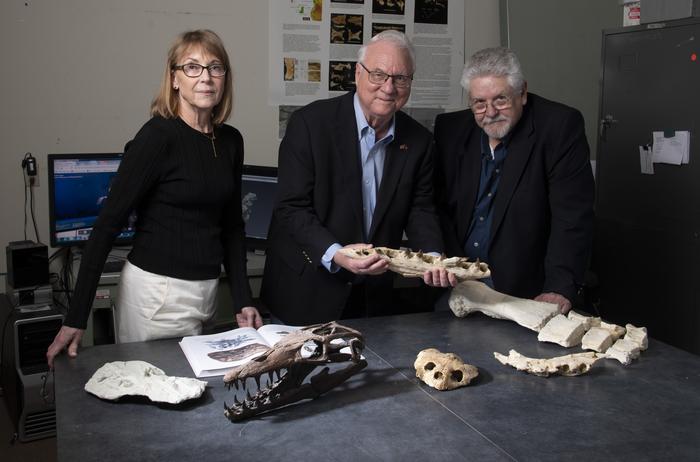DALLAS (SMU) – An SMU-led research team has found that ancient rocks and fossils from long-extinct marine reptiles in Angola clearly show a key part of Earth’s past – the splitting of South America and Africa and the subsequent formation of the South Atlantic Ocean.

Credit: SMU, Hillsman S. Jackson
DALLAS (SMU) – An SMU-led research team has found that ancient rocks and fossils from long-extinct marine reptiles in Angola clearly show a key part of Earth’s past – the splitting of South America and Africa and the subsequent formation of the South Atlantic Ocean.
With their easily visualized “jigsaw-puzzle fit,” it has long been known that the western coast of Africa and the eastern coast of South America once nestled together in the supercontinent Gondwana — which broke off from the larger landmass of Pangea.
The research team says the southern coast of Angola, where they dug up the samples, arguably provides the most complete geological record ever recorded on land of the two continents moving apart and the opening of the South Atlantic Ocean. Rocks and fossils found date back from 130 million years ago to 71 million years.
“There are places that you can go to in South America, for instance, where you can see this part of the split or that part of it, but in Angola, it’s all laid out in one place,” said Louis L. Jacobs, SMU professor emeritus of Earth Sciences and president of ISEM. Jacobs is the lead author of a study published in The Geological Society, London, Special Publications.
“Before this, there was not a place known to go and see the rocks on the surface that really reflected the opening of the South Atlantic Ocean, because they’re now in the ocean or eroded away,” Jacobs said.
Angola rocks and fossils tell the whole story
Africa and South America started to split around 140 million years ago, causing gashes in Earth’s crust called rifts to open up along pre-existing weaknesses. As the tectonic plates beneath South America and Africa moved apart, magma from the Earth’s mantle rose to the surface, creating a new oceanic crust and pushing the continents away from each other. And eventually, the South Atlantic Ocean filled the void between these two newly-formed continents.
Scientists have previously found evidence of these events through geophysics and well cores drilled through the ocean floor.
But these tell-tale signs have never been found in one place, or been so clearly visible for anyone to see, said study co-author Michael J. Polcyn, research associate in the Huffington Department of Earth Sciences and senior research fellow, ISEM at SMU.
“It’s one thing for a geophysicist to be able to look at seismic data and make inferences from that,” he said. “It’s quite another thing to be able to take a school field trip out to the rock formations, or outcrops, and say this is when the lava was spreading from eastern South America. Or this was when it was a continuous land.”
Essentially, Angola presents the opportunity for someone to easily walk through each phase of this geologically significant chapter in Earth’s history.
“That gives Angola major bragging rights,” Jacobs said.
Jacobs, Polcyn and Diana P. Vineyard – who is a research associate at SMU – worked with an international team of paleontologists, geologists and others to analyze both the rock formations they found in eight different locations on the coast and the fossils within them.
Fieldwork in Angola’s Namibe Province began in 2005. At that time, the research team recognized particular types of sediments, which gave them a good indication of what the western coast of Africa had been like at various stages millions of years ago. For instance, fields of lava revealed volcanic outpourings, and faults or breaks showed where the continents were being rifted apart. Sediments and salt deposits showed ocean flooding and evaporation, while overlying oceanic sediments and marine reptiles showed completion of the South Atlantic Ocean.
Paleontologists, meanwhile, discovered fossils in Angola from large marine reptiles that had lived late during the Cretaceous Period, right after the Atlantic Ocean was completed and while it grew wider.
By bringing together experts from a wide range of fields, “we were able to document when there was no ocean at all, to when there was a fresh enough ocean for those reptiles to thrive and have enough to eat,” Vineyard said.
Many of the ancient fossils are currently on display at the Smithsonian’s National Museum of Natural History “Sea Monsters Unearthed: Life in Angola’s Ancient Seas” exhibit, which was co-produced with SMU – a nationally-ranked Dallas-based private university.
Angolan researchers – Nair de Sousa, a geoscientist and energy consultant at the African Circular Business Alliance, and Pedro Claude Nsungani, a geology professor at the Universidade Agostinho Neto – also played a key role in this research.
About SMU
SMU is the nationally ranked global research university in the dynamic city of Dallas. SMU’s alumni, faculty and more than 12,000 students in eight degree-granting schools demonstrate an entrepreneurial spirit as they lead change in their professions, communities and the world.
Journal
Geological Society London Special Publications
Method of Research
Meta-analysis
Subject of Research
Not applicable
Article Title
The Atlantic jigsaw puzzle and the geoheritage of Angola
Article Publication Date
8-Mar-2024



